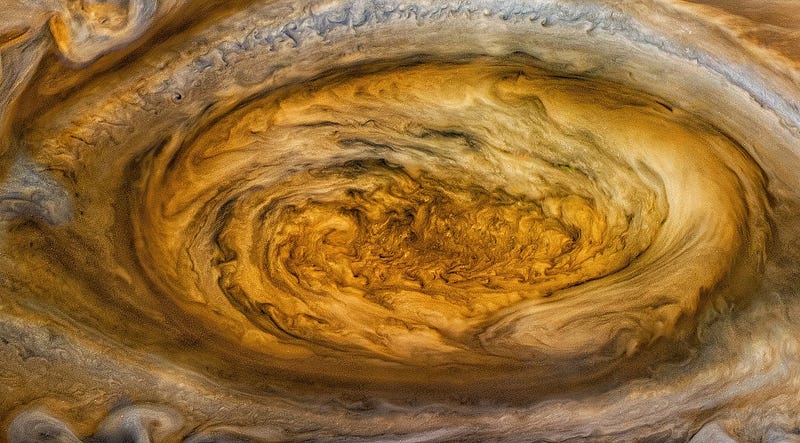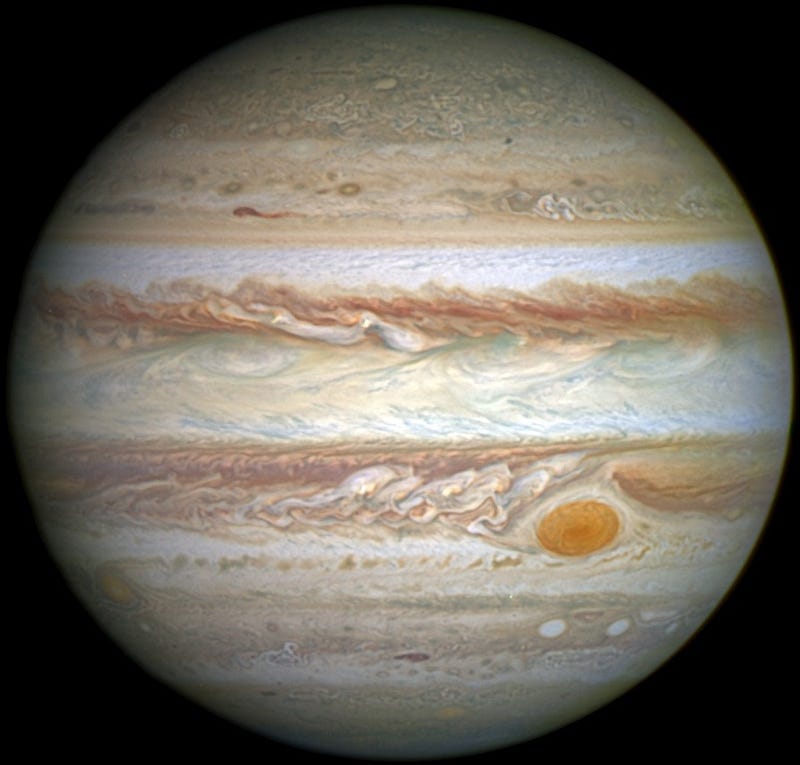The Great Red Spot: Jupiter's Enigmatic Storm Unraveled
Written on
Chapter 1: Understanding the Great Red Spot
What exactly is the Great Red Spot? Where can it be found, and what secrets does it conceal?
This enormous storm, the largest in our Solar System, rivals the size of Earth itself. It has been observed on Jupiter for a minimum of 150 years, although it likely predates this observation period. This massive atmospheric phenomenon is visible from Earth using telescopes, earning its name as the Great Red Spot.

[Photo: Kevin Gill from Los Angeles, CA, United States, CC BY 2.0, via Wikimedia Commons]
Jupiter, a breathtaking planet in our solar system, has been captured in stunning images by numerous probes and telescopes, from Voyager 1 to the James Webb Telescope. These images reveal a planet adorned with thick, horizontal bands in varying shades of beige, punctuated by smaller and larger white ovals—signs of storms. These storms can be fleeting, as seen on Earth, or they can persist for extended periods.
Among the many swirling patterns on Jupiter’s surface, a notable feature in the southern hemisphere is the Great Red Spot, located 22 degrees south of the equator. This powerful anticyclone rotates counterclockwise and has been affectionately nicknamed "the Pancake" due to its shape. Its reddish hue can shift, fluctuating between brighter and darker tones.
How Long Has the Great Red Spot Been Around?
While Earth’s longest-lasting storm, Hurricane John, lasted just 31 days in 1994, the Great Red Spot has been a constant for much longer. Regular observations began in 1831, and continuous tracking has been maintained since 1879. Historical accounts suggest that astronomers Robert Hooke in 1664 and Giovanni Cassini in 1665 may have witnessed it too. If Cassini’s “permanent spot” referred to the Great Red Spot, then this storm has been active for over 350 years.

[Photo: NASA, ESA, and A. Simon (Goddard Space Flight Center), Public domain, via Wikimedia Commons]
Why Has the Great Red Spot Endured?
What contributes to the longevity of the Great Red Spot? At least two factors are noteworthy. Firstly, hurricanes on Earth tend to weaken as they move over land, but Jupiter lacks solid ground. While it may have a core and an ocean of liquid hydrogen, above that lies only a vast atmosphere. As a result, the Great Red Spot faces no barriers to its existence.
Secondly, this storm behaves like a factory wheel, operating between two opposing jet streams. The weaker jet current underneath flows eastward, while the strong upper current moves westward. According to Glenn Orton, a member of the Juno probe team that captured images of the storm, "The Great Red Spot has proven to be so stable and long-lived because it has been wedged between two opposing jet currents."
Will the Great Red Spot Eventually Vanish?
In 2018, alarming reports suggested that the Great Red Spot could disappear soon. Predictions indicated that it would complete a full rotation in ten years and vanish entirely in twenty.
Is this a realistic expectation? The Great Red Spot has indeed been shrinking since observations began. In the 19th century, it was so expansive that scientists estimate it could contain three to four Earths within its bounds, stretching an impressive 56,000 kilometers. Today, however, it has diminished to approximately the diameter of our planet.
Interestingly, this perception of the storm as a flat feature is misleading. As the area of the anticyclone decreases, it becomes taller—similar to clay being shaped on a potter’s wheel. Thus, while it is becoming more compact, predictions about its future remain uncertain.
Secrets Behind the Great Red Spot
The rotation speed of the anticyclone changes based on measurement points. Recent studies revealed that winds at its edges are accelerating, with speeds increasing by 8% from 2009 to 2020, now exceeding 640 km/h. Closer to the center, conditions are much calmer.
The reason for the Great Red Spot's reddish color remains elusive. Researchers are investigating which chemical compounds in Jupiter's clouds produce this hue under anticyclone conditions. So far, ammonium hydrosulfide is the leading candidate among the three primary components of Jupiter's clouds.
In 2018, astrochemist Mark Loeffler conducted experiments that revealed that ammonium hydrosulfide, when subjected to simulated cosmic radiation at temperatures reminiscent of the Great Red Spot, shifted to a greenish color. Therefore, it cannot solely account for the storm's red appearance.
Loeffler's research suggests that under ultraviolet radiation, reddish compounds, potentially tholins found on Pluto, may form within the anticyclone.
Additionally, the Great Red Spot is remarkably noisy. Its immense size and rapid rotation generate powerful acoustic waves that rise above the storm, dissipating into the upper atmosphere at altitudes of 800 km. This phenomenon heats the upper atmosphere to staggering temperatures, sometimes exceeding 1,300 degrees Celsius—significantly hotter than other regions of Jupiter's atmosphere.
Source: Space.com [1] and [2], Icarus, Nature, ScienceAlert, NASA
The first hyperrealistic sculpture of Jesus. The model was the shroud of Turin!
The Shroud of Turin is considered one of the most valuable relics of Christianity. The mysterious cloth allowed artists…
Thank you for reading this article! If you found it informative, I would greatly appreciate your support through claps or following me. A tip would also be wonderful! Thank you!